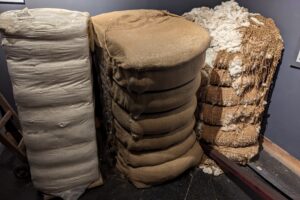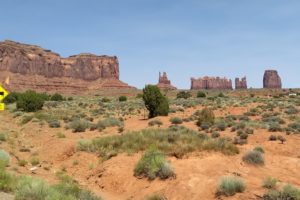In 1901, Theodore Roosevelt because our 26th President and one of our greatest conservationists. When he was here in the ND badlands in 1883, he came to hunt bison. By the time he left in 1885, he had created a home, thrived on the vigorous outdoor lifestyle, and actively participated in the life of a working cowboy. His first cabin was originally about 7 miles south of Medora where we’re staying, but eventually it was moved to the national park headquarters in 1959.



Roosevelt’s first home here

A few months later he came back to the Badlands to find peace for his grieving heart. This cabin was his home in 1884.
Roosevelt did find peace and renewed strength of spirit and body by his time here. Expanding his ranching operations, he started a second ranch, the Elkhorn, and moved there in 1885.
The Maltese Cross 1-1/2 story cabin had a shingle roof and cellar. It was constructed of durable ponderosa pine logs that had been cut and floated down the Little Missouri River. It was considered to be a mansion in its day with wooden floors and 3 separate rooms (kitchen, living room, Roosevelt’s bedroom). The steeply pitched roof, unusual for the northern plains, created an upstairs sleeping loft for the ranch hands.
Items in this cabin either belonged to Theodore Roosevelt or came from the same time period and were typical furnishings of the day.
The replica writing desk from the Elkhorn Ranch stands as witness to the many hours he spent recording his incredible adventures and experiences that would later become valuable lessons when he became president.

He saw the wreckage caused by overgrazing when ranchers lost up to 90% of their herds to starvation. He lived the consequences brought about by short-sighted, wasteful practices.


When Roosevelt got excited about a topic, usually politics, he would rock himself all around a room. As president, Theodore Roosevelt set aside over 230 million acres of public land as National Forests, Parks, Monuments, and Refuges to protect wildlife, habitats, and scenery. This action earned him the title “Conservationist President.”
I remember a line of rocking chairs like these in my grandpa’s and aunt’s farms in southern Iowa when I visited them with my family in the 1950s.





Roosevelt actively ranched in the badlands until 1887 but maintained interests in the area until 1898.
Roosevelt in ND

Roosevelt enjoyed “the glory of work and the joy of living” on the ranch. Later on he claimed that his experiences in ND propelled him to be president.

At just 23 years old, Roosevelt set off from NYC in September 1883 to search for adventure in the West. He arrived at the train station in the town of Little Missouri early in the morning (on the left picture) and spent his 1st night in the badlands at the Pyramid Park Hotel (on the right).

He purchased the Maltese Cross Ranch (that we’ve seen in this post), which included a few hundred cattle and a few small sheds. He instructed his hired ranch hands to build a cabin for his return the next summer. After he returned home, his wife and mother both died on the same terrible day for him—February 14, 1884.

He expanded his ranching operation to a remote location along the Little Missouri River, about 30 miles north of Medora.
By mid-October, his hired men, Wilmot Dow and Bill Sewall, had moved onto the Elkhorn Ranch site and were cutting and collecting cottonwood logs for the ranch house. Working throughout the winter, they completed the house by spring 1885.
The 8-room house stood 30 x 60 feet, with 7-foot-high walls. A porch hugged the east side (to capture the sunrise?). Dow and Sewall also built 2 stables with a connecting roof, a cattle shed, a chicken house, and a blacksmith shop. Roosevelt called this second ranch, the Elkhorn, his home ranch.
By 1887, drought and blizzards had destroyed Roosevelt’s herds. By this time he was feeling stronger emotionally because of his time on the ranch. He gave up ranching and moved permanently back to New York to continue his political career.
While the cabin is no longer standing, the stones mark the house’s foundation and exhibit panels tell about ranch life and floodplain habitat. This area is the most historically significant part of the park’s 3 units. Much of the route to the ranch is unpaved. The last 3 miles sometimes requires a 4-wheel drive and/or a high-clearance vehicle.
Now some more history of this area.
bridge across the Little Missouri
Motorists had to ford the river or wait for a railroad crew to carry their autos across on a flatcar—a real challenge for motorists. Construction of a transcontinental highway system began in 1912 but was slowed down by the lack of proper river crossings.


Donations for the bridge ranged from $800 (now $20,625) to $1700 (now $43,828) were collected. For a time the span was known locally as “The Bridge That Boost Built.”
In 1915, the Illinois Steel Bridge Company starting building the bridge. The narrow, steel-truss structure had three 137-foot 9-inch spans supported by 24-foot high steel piers that rested on a 10-foot thick concrete base. The final cost was $14,580 (now $375,887). Grading and road fees were an additional $3200 (now $82,500).

This bridge continued to be used until it was replaced in 1942 by a 32-foot wide bridge.

military presence

General Sully led the first military expedition to cross the badlands in 1864. He and his 2200 men and a large civilian wagon train entered from the east on August 6, fresh from a victory on July 28 over the Sioux Indians at Killdeer Mountain, which was the largest ever carried out by the U.S. Army against Indians.

Sully had a hard time finding a route across the rugged terrain, but a young Indian scout helped him blaze a trail several miles south of present-day Medora. Sully and his men emerged from the badlands 3 days later after skirmishing with the Sioux in a fight known as the Battle of the Badlands.

Military expeditions in 1871 – 1873 provided protection for railroad survey crews. Lt. Colonel Custer and his Seventh U.S. Calvary were part of the 1873 escort. Custer and his regiment passed through this area in 1876 on their way to their defeat at the Little Bighorn River in Montana. The Custer Trail is now identified and marked for posterity.
In 1876, General George Crook passed through from the west before turning south toward the Black Hills, desperately marching for supplies.
In 1879, just 3 years later, the U.S. military established its presence with the Bad Lands Cantonment (info in this post). Its presence was abandoned in early 1883 when the Indian threat was gone.
a town

The town of Little Missouri was founded in 1880 on the west bank of the river where the Northern Pacific Railroad section house and depot had been.

The badlands were becoming a destination for hunters, scientists, and tourists. Little Missouri (town) grew to include Big-Mouthed Bob’s Bug Juice Dispensary (a tavern?), a general store, and a boarding house.

Earlier that year, the Marquis de Mores established a new town on the east side of the river and named it Medora. As his town grew, Little Missouri lost its population. The railroad wanted to move the Little Missouri depot to the new town, but the structure was too wide to fit through the railroad bridges. Instead it was sold to a rancher who lived about 40 miles south of Medora.
military presence


A small detail of soldiers pursued a raiding party that was about 12 miles west of the cantonment. During a brisk engagement, the soldiers’ horses became frightened and ran into the Indians’ herd and were captured. The soldiers had to walk back, arriving about midnight. The soldiers never did get their horses back.
The military abandoned the cantonment in March 1883, but its buildings were used for Medora’s first school and later the offices of a local newspaper.



history of Medora

For a few years the town grew and thrived while the local cattle industry flourished. A severe winter in 1886-87 killed much of the area’s livestock, causing the industry, and eventually the town, to collapse.

Only a chimney and a few stone walls are what’s left of De Mores meat packing plant, the cornerstone operation and the Marquis’ chief business venture (right side of picture). Initially shipping beef in refrigerated railcars was profitable, but as the herds were devastated, the meat packing plant went out of business.

The tiny town of Little Missouri (right side of the picture) got its start around 1880 when the railroad arrived and a military cantonment was constructed nearby. The town slowly dissolved after Medora was founded on the other side of the Little Missouri River.

town of Medora and its campground
Medora is a small town with a population of 112 at the 2010 census, but it has a big heart for those who come to visit.




reasons to return to Medora
The De Mores State Historic Site featuring “the chateau” actually closed on Labor Day so we weren’t able to visit (a good reason to return). The Marquis’ dream was to build a cattle empire in the American West. His plan was to slaughter range cattle at Medora, ship dressed meat east in refrigerated rail cars, and provide urban consumers with a better quality product. For 3 years he built his dream along with the town, but then a drought in the badlands ended his dream in 1886.
The ND Cowboy Hall of Fame was still open, but my foot hurt enough that I’d opted for seeing it the next time we came here.
Also closed down for the season was the Medora Musical that’s an ode to patriotism, Theodore Roosevelt, and the Spirit of the Badlands. If you plan on going to the musical, be sure to catch the Pitchfork Steak Fondue (also closed) before the musical starts. You’ll get dinner and a show with a beautiful view of the badlands. Other performances are available for visitors during the summer and at Christmas.
next
In the next post we’ll learn a little more about where we are, and then we’ll get to start exploring the park!




